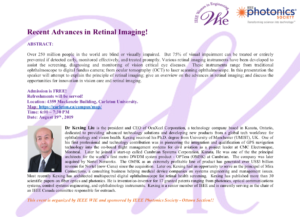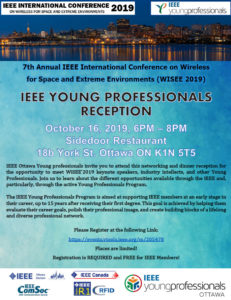Events
GNSS
Antennas for Autonomous Vehicles:
What You Need to Know!
Â
Precise
and reliable positioning recently became a critical property of autonomous
vehicles like drones, driverless cars and more. Tallysman Wireless will explain
why the GNSS antenna is the most important component for accurate positioning
and will present the challenges of selecting the appropriate GNSS antenna for
diverse types of autonomous vehicles. Multiple properties of a GNSS antenna
like its phase center variation, ability to reject interferences or multipath
and sensibility to its environment will be analysed and guide lines will be
proposed.
Â
Refreshments will be served!
Location: 4359 Mackenzie Building, Carleton University.
Map: https://carleton.ca/campus/map/
Time: 6:00 – 7:00 PM
Date: July 17th , 2019
Â
BIOGRAPHY:
Julien
Hautcoeur received the M.Sc. degree in radio communication systems and
electronics from the Ecole Polytechnique of the University of Nantes, Nantes,
France, in 2007 and the Ph.D. degree in signal processing and
telecommunications from the Institute of Electronics and Telecommunications of
Rennes 1, Rennes, France, in 2011. In 2011, he was involved in postdoctoral
training at the University of Quebec in Outaouais (UQO), Gatineau, QC, Canada.
His research field was optically transparent antenna systems for telecommunications.
Since 2014 he works at Tallysman Wireless in Ottawa, Canada and specialized in
the design of high performance GNSS antennas and associated electronics.
GPSPlacement

ABSTRACT:
Over 250 million people in the world are blind or visually impaired. But 75% of visual impairment can be treated or entirely prevented if detected early, monitored effectively, and treated promptly. Various retinal imaging instruments have been developed to assist the screening, diagnosing and monitoring of vision critical eye diseases. These instruments range from traditional ophthalmoscope to digital fundus camera; from ocular tomography (OCT) to laser scanning ophthalmoscope. In this presentation the speaker will attempt to explain the principle of retinal imaging; give an overview on the advances in retinal imaging; and discuss the opportunities for innovation in vision care and retinal imaging.
SPEAKER:
Dr Kexing Liu is the president and CEO of OcuXcel Corporation, a technology company based in Kanata, Ontario, dedicated to providing advanced technology solutions and developing new products from a global tech workforce for ophthalmology and vision health. Kexing received his Ph.D. degree from University of Manchester (UMIST), UK. One of his first professional and technology contribution was in pioneering the integration and qualification of GPS navigation technology into the on-board flight management systems for civil aviation as a project leader at CMC Electronique, Montreal. Later he joined a start-up called Cambrian Systems Corporation, Kanata, He was one of the the principal architects for the world’s first metro DWDM system product – OPTera (OM5K) at Cambrian. The company was later acquired by Nortel Networks. The OM5K as an extremely profitable line of product has generated over US$3 billion revenue for Nortel (now Ciena) since the acquisition. Later on, Kexing had an opportunity to serve as the principal of Mira Connections, a consulting business helping medical device companies on systems engineering and management issues. Most recently Kexing has architected multispectral digital ophthalmoscope for retinal health screening. Kexing has published more than 30 scientific papers on fiber optics and photonics. He is inventor/co-inventor for 17 granted patents ranging from photonics, optical communications systems, control systems engineering, and ophthalmology instruments. Kexing is a senior member of IEEE and is currently serving as the chair of an IEEE Canada committee responsible for outreach.
This event is organized by IEEE WIE and sponsored by IEEE Photonics Society – Ottawa Section!!
Kexing
The Ottawa Section of the Institute of Electrical and Electronics Engineers (IEEE) and the Canada Aviation and Space Museum cordially invite you to:
The dedication of the IEEE engineering milestone “First Search and Rescue Using Satellite Technology, 1982â€
Join us at the museum for this special event, where we will also celebrate space-related technical achievements as part of the commemoration of the fiftieth anniversary of humans landing on the Moon.
WHO:
The keynote speaker at the dedication ceremony is renowned Canadian astronaut, Dr. Robert Thirsk. Special guests include IEEE President, Dr. José Moura, and IEEE Canada President, Dr. Maike Luiken.
WHAT:
A dedication and unveiling ceremony for two plaques (English and French), recognizing the historical significance of this satellite technology application.
WHEN:
Monday, September 9, 2019 at 2 p.m.
WHERE:
The grounds of the Canada Aviation and Space Museum, 11 Aviation Parkway, Ottawa, ON.
AGENDA:
2 p.m. – 2:45 p.m.:
- Opening remarks and welcome by IEEE Ottawa Section Chair, Dr. Winnie Ye, and IEEE History Committee Chair, Dr. Branislav Djokic
- Welcome address by the Director General of the Canada Aviation and Space Museum, Mr. Chris Kitzan
- Historical perspective on this IEEE milestone by Dr. Michael A. Stott
- Welcome address by IEEE Canada President, Dr. Maike Luiken, and IEEE President, Dr. José Moura
- Keynote speech by Dr. Robert Thirsk
- Unveiling of the plaques by Dr. Robert Thirsk
- Closing remarks by IEEE Ottawa Section Vice-Chair, Mr. Ajit Pardasani
2:45 p.m. – 3:30 p.m.:
- Light refreshments and networking
RSVP:
Ajit Pardasani at Ajit.Pardasani@ieee.org by September 3, 2019.
Advanced Optical Sources for Spectrally Efficient Photonic Systems
Liam Barry,
Dublin City University
Â
Abstract
The continuing growth in demand for bandwidth (from residential and business users), necessitates significant research into new advanced technologies that will be employed in future broadband communication systems. Two specific technologies which are becoming increasingly important for future photonic
systems are wavelength tunable lasers and optical frequency combs. Although these topics have been studied for over two decades their significance for the development of future ultra-high capacity photonic systems has only recently been fully understood. Wavelength tunable lasers are currently becoming the
norm in optical communication systems because of their flexibility and ability to work on any wavelength. However, as their operating principles are different to standard single mode lasers they can effect how future systems will operate.
For example as optical transmission systems move towards more coherent transmission (where the data is carried using both the intensity and phase of the optical carrier), the phase noise in these tunable lasers will become increasingly important. Optical frequency combs also have many applications for
future photonics systems, and for telecommunications they can be used to obtain the highest spectral efficiency in optical transmission systems by employing the technology of optical frequency division multiplexing (OFDM) that has been widely employed to increase spectral efficiency in wireless systems. Wavelength tunable lasers and optical frequency combs are thus topics at the leading edge of current photonics systems research, and their detailed understanding promises new applications in all-optical signal processing, optical sensing and metrology, and specifically telecommunications. This talk will focus on the development and characterization of various wavelength tunable lasers and optical frequency combs, and then outline how these sources can be employed for developing optical transmission systems and networks which make the best use of available optical spectrum.
Bio
Liam Barry received his BE (Electronic Engineering) and MEngSc (Optical Communications) from University College Dublin and his PhD from the University of Rennes. His main research interests are: all-optical signal processing, optical pulse generation and characterization, hybrid radio/fibre communication
systems, wavelength tuneable lasers for reconfigurable optical networks, and optical performance monitoring. He has worked as a Research Engineer in the Optical Systems Department of France Telecom’s Research Laboratories (now known as Orange Labs), and a Research Fellow at the Applied Optics Centre in Auckland University. He is currently a Full Professor in the School of Electronic Engineering at Dublin City University, establishing the Radio and Optical Communications Laboratory, and is a Principal Investigator for Science Foundation Ireland. He has published over 500 articles in internationally peer reviewed journals and conferences, holds 9 patents in the area of optoelectronics, and has co-founded two companies in the photonics sector.

Young Professionals Reception
During the 7th Annual IEEE International Conference on Wireless for Space and Extreme Environments (WISEEÂ 2019)
Wednesday, October 16th from 6:00 PM – 8:00 PM
Sidedoor Restaurant
18b York St, Ottawa, ON K1N 5T5
IEEE Ottawa Young Professionals (YPs) and IEEE WiSEE’2019 Organizing Committee invite all YPs in Ottawa and those attending the 2019 IEEE WiSEE Conference to join the Young Professionals Reception on Wednesday, October 16th, 2019 from 6:00 – 8:00 PM taking place at Sidedoor restaurant at 18b York St, Ottawa, K1N 5T5. Come ready to meet WiSEE Keynote Speakers, Industry intellects, and other Young Professionals, and learn about the different opportunities available through the IEEE and the Young Professionals Program.
The IEEE Young Professionals Program is aimed at supporting IEEE members at an early stage in their career, up to 15 years after their first degree, by helping them evaluate their career goals, polish their professional image, and create building blocks of a lifelong and diverse professional network.
IEEE_WiSEE_YP_Reception_Poster

